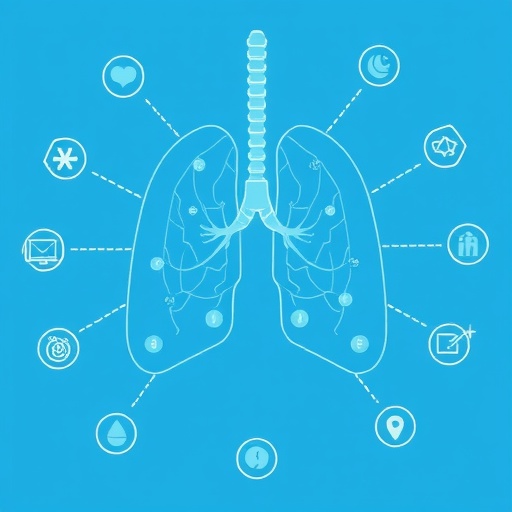In a groundbreaking intersection of machine learning and chronic illness management, researchers have unveiled a sophisticated tool designed to predict depression risk in older adults suffering from asthma. This newly developed Depression Risk Identification Tool (DRIT) marks a significant advance in the holistic care of patients grappling with the dual challenges of a persistent respiratory condition and mental health vulnerabilities. By harnessing the power of advanced algorithms, this tool offers clinicians the ability to foresee depression risk with unprecedented accuracy, potentially revolutionizing patient outcomes in this vulnerable demographic.
Asthma, a chronic inflammatory disease characterized by airway constriction and breathing difficulties, affects millions worldwide, with the burden disproportionately impacting older adults. This group frequently experiences compounded health challenges, including an increased prevalence of depression—an often-overlooked comorbidity that exacerbates disease progression and diminishes quality of life. The coexistence of these conditions presents complex barriers to effective healthcare delivery, necessitating integrative approaches capable of addressing both physical and psychological domains.
The development of the DRIT involved comprehensive secondary analysis of an extensive dataset sourced from the China Health and Retirement Longitudinal Study (CHARLS). This dataset encompassed over a thousand asthmatic individuals, offering rich, multidimensional insight into health, behavior, and socio-demographic variables affecting this population. By applying the LASSO regression method to this dataset, the research team identified 21 critical predictors that significantly correlate with depression risk among these patients.
LASSO regression, known for its ability to perform variable selection and regularization to enhance model precision, facilitated the distillation of vast data into a coherent set of influential risk factors. These predictors ranged from cognitive function measures to lifestyle behaviors, highlighting the multifaceted nature of depression risk in the context of chronic asthma. The rigorous feature selection process ensured that subsequent machine learning modeling would focus on the most relevant variables, optimizing predictive capacity.
To identify the most effective predictive mechanism, the researchers assessed eight distinct machine learning algorithms, each with unique strengths in handling complex, nonlinear data patterns. Among these, the generalized linear model with boosting (glmBoost) emerged as the superior framework. The glmBoost model demonstrated notable robustness and accuracy during validation phases, achieving an area under the receiver operating characteristic curve (AUC) of 0.740 in the testing cohort and 0.664 in an independent validation cohort.
AUC values, indicative of the model’s discriminative ability, underscore the tool’s capacity to reliably distinguish between high and low depression risk individuals. These metrics are essential benchmarks in predictive modeling, reflecting both sensitivity and specificity. Such performance suggests that the DRIT can serve as a clinically actionable instrument, guiding practitioners in early detection and proactive intervention strategies.
Among the risk factors elucidated by the model, diminished cognitive function stood out as a predominant contributor to depression vulnerability. This finding aligns with existing literature that underscores cognitive decline as a critical determinant in mental health trajectories among aging populations. Notably, behavioral factors such as engaging in heavy physical exercise and marital status also emerged as significant, providing nuanced insights into how lifestyle and social dynamics intersect with psychological well-being.
Gender differences revealed by the model highlight the increased susceptibility of female asthma patients to depression, a trend consistent with broader epidemiological observations. These insights invite further exploration into the biological, hormonal, and sociocultural dimensions underpinning gender disparities in mental health, especially within chronic disease contexts.
Enhancing the interpretability of the DRIT, researchers employed SHapley Additive exPlanations (SHAP) values to dissect the influence of individual predictors on risk estimations. This approach offers granular transparency, allowing clinicians and stakeholders to visualize how various factors integrate to shape depression risk profiles. The interpretability fosters clinical confidence and can facilitate personalized interventions that address specific patient vulnerabilities.
While the DRIT represents a significant advancement, the study acknowledges inherent limitations rooted in the reliance on survey-collected data. Surveys, despite their breadth and depth, cannot capture the full spectrum of biological, environmental, and psychosocial variables influencing depression. Moreover, the generalizability of findings needs to be tested across diverse populations beyond the sampled Chinese cohort, warranting expansive cross-cultural validation.
Looking ahead, integrating this predictive tool into routine clinical practice could transform the management of older asthma patients by enabling timely, targeted psychological support. Depression, often underdiagnosed in this group due to overlapping symptoms and stigma, can thus be addressed before it escalates, potentially mitigating its detrimental effects on asthma control and overall health outcomes.
The DRIT exemplifies the promise of precision medicine powered by machine learning, bridging the gap between complex data analytics and tangible clinical utility. As we move towards increasingly personalized healthcare frameworks, such tools will be invaluable in unraveling the intricate interplay of chronic physical illnesses and mental health, ultimately driving improved patient-centric care.
This study signifies a pivotal moment in digital health innovation, offering a scalable, data-driven solution that marries technological prowess with compassionate care imperatives. Its success not only underlines the critical importance of interdisciplinary research but also sets the stage for future advancements that harness artificial intelligence to unravel and address multifactorial health challenges.
As the global population ages and chronic diseases become more prevalent, tools like the DRIT will be critical in alleviating healthcare system burdens, improving life quality, and enabling proactive healthcare delivery. The ongoing refinement and validation of such models will shape the next frontier in managing complex chronic conditions through integrative, prediction-focused strategies.
Subject of Research: Development of a machine learning-based tool for predicting depression risk in older adults with asthma.
Article Title: Development of a machine learning-based depression risk identification tool for older adults with asthma.
Article References: An, L., Wang, X., Jia, L. et al. Development of a machine learning-based depression risk identification tool for older adults with asthma. BMC Psychiatry 25, 860 (2025). https://doi.org/10.1186/s12888-025-07338-6
Image Credits: AI Generated
DOI: https://doi.org/10.1186/s12888-025-07338-6




